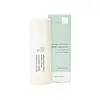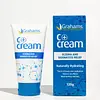What's inside
What's inside
 Key Ingredients
Key Ingredients

 Benefits
Benefits

 Concerns
Concerns

 Ingredients Side-by-side
Ingredients Side-by-side

Water
Skin ConditioningGlycerin
HumectantIsopropyl Myristate
EmollientCoco-Caprylate
EmollientUrea
BufferingGlyceryl Stearate
EmollientCetearyl Glucoside
EmulsifyingSodium Stearoyl Glutamate
CleansingCetearyl Alcohol
EmollientCetyl Alcohol
EmollientPlant Ash Extract
Hamamelis Virginiana Extract
AntiseborrhoeicArgania Spinosa Kernel Oil
EmollientPhyllanthus Emblica Fruit Extract
HumectantButyrospermum Parkii Butter
Skin ConditioningPhenoxyethanol
PreservativeHydrogenated Vegetable Oil
EmollientTocopheryl Acetate
AntioxidantAlcohol
AntimicrobialLactic Acid
BufferingParfum
MaskingWater, Glycerin, Isopropyl Myristate, Coco-Caprylate, Urea, Glyceryl Stearate, Cetearyl Glucoside, Sodium Stearoyl Glutamate, Cetearyl Alcohol, Cetyl Alcohol, Plant Ash Extract, Hamamelis Virginiana Extract, Argania Spinosa Kernel Oil, Phyllanthus Emblica Fruit Extract, Butyrospermum Parkii Butter, Phenoxyethanol, Hydrogenated Vegetable Oil, Tocopheryl Acetate, Alcohol, Lactic Acid, Parfum
Water
Skin ConditioningLanolin
EmollientSqualane
EmollientCetearyl Alcohol
EmollientGlyceryl Stearate
EmollientCaprylic/Capric Triglyceride
MaskingIsopropyl Myristate
EmollientHoney
HumectantSimmondsia Chinensis Seed Oil
EmollientCalendula Officinalis Extract
Skin ConditioningCentella Asiatica Extract
CleansingPhenoxyethanol
PreservativeCaprylyl Glycol
EmollientSodium Stearoyl Glutamate
CleansingSorbitol
HumectantHippophae Rhamnoides Fruit Oil
Skin ProtectingStearic Acid
CleansingCyamopsis Tetragonoloba Gum
Emulsion StabilisingSodium PCA
HumectantXanthan Gum
EmulsifyingTocopherol
Antioxidant3-O-Ethyl Ascorbic Acid
Skin ConditioningLactic Acid
BufferingWater, Lanolin, Squalane, Cetearyl Alcohol, Glyceryl Stearate, Caprylic/Capric Triglyceride, Isopropyl Myristate, Honey, Simmondsia Chinensis Seed Oil, Calendula Officinalis Extract, Centella Asiatica Extract, Phenoxyethanol, Caprylyl Glycol, Sodium Stearoyl Glutamate, Sorbitol, Hippophae Rhamnoides Fruit Oil, Stearic Acid, Cyamopsis Tetragonoloba Gum, Sodium PCA, Xanthan Gum, Tocopherol, 3-O-Ethyl Ascorbic Acid, Lactic Acid
Ingredients Explained
These ingredients are found in both products.
Ingredients higher up in an ingredient list are typically present in a larger amount.
Cetearyl alcohol is a mixture of two fatty alcohols: cetyl alcohol and stearyl alcohol. It is mainly used as an emulsifier. Emulsifiers help prevent the separation of oils and products. Due to its composition, it can also be used to thicken a product or help create foam.
Cetearyl alcohol is an emollient. Emollients help soothe and hydrate the skin by trapping moisture.
Studies show Cetearyl alcohol is non-toxic and non-irritating. The FDA allows products labeled "alcohol-free" to have fatty alcohols.
This ingredient is usually derived from plant oils such as palm, vegetable, or coconut oils. There is debate on whether this ingredient will cause acne.
Due to the fatty acid base, this ingredient may not be Malassezia folliculitis safe.
Learn more about Cetearyl AlcoholGlyceryl Stearate is a mix of glycerin and stearic acid.
It is used to stabilize the mixing of water and oil ingredients. By preventing these ingredients from separating, it can help elongate shelf life. It can also help thicken the product's texture.
As an emollient, it helps soften skin and supports barrier-replenishing ingredients.
In cosmetics, Glyceryl Stearate is often made from vegetable oils or synthetically produced.
This ingredient may not be fungal-acne safe
Fun fact: The human body also creates Glyceryl Stearate naturally.
Learn more about Glyceryl StearateIsopropyl Myristate is an emollient, thickening agent, and texture enhancer. It is created from isopropyl alcohol and myristic acid.
It is used to help other ingredients be better absorbed. It is also an emollient and may help soften and hydrate the skin.
The comedogenic rating of this ingredient depends on the concentration. Lower amounts results in a lower rating.
Isopropyl Myristate may not be fungal acne safe. It can potentially worsen acne prone skin.
Learn more about Isopropyl MyristateLactic Acid is another well-loved alpha hydroxy acid (AHA). It is gentler than glycolic acid but still highly effective.
Its main role is to exfoliate the surface of the skin by loosening the “glue” that holds dead skin cells together. Shedding those old cells leads to smoother, softer, and more even-toned skin.
Because lactic acid molecules are larger than glycolic acid, they don’t penetrate as deeply. This means they’re less likely to sting or irritate, making it a great choice for beginners or those with sensitive skin.
Like glycolic acid, it can:
Lactic acid also acts as a humectant (like hyaluronic acid). It can draw water into the skin to improve hydration and also plays a role in the skin's natural moisturizing factor (NMF) in the form of sodium lactate.
Studies show it can boost ceramide production to strengthen the skin barrier and even help balance the skin’s microbiome.
To get results, choose products with a pH between 3-4.
Lower strengths (5-12%) focus on surface exfoliation; higher strengths (12% and up) can reach deeper in the dermis (deeper, supportive layer) to improve skin texture and firmness over time.
Though it was originally derived from milk, most modern lactic acid used in skincare is vegan. It is made through non-dairy fermentation to create a bio-identical and stable form suitable for all formulations.
When lactic acid shows up near the end of an ingredient list, it usually means the brand added just a tiny amount to adjust the product’s pH.
Legend has it that Cleopatra used to bathe in sour milk to help reduce wrinkles.
Lactic acid is truly a gentle multitasker: it exfoliates, hydrates, strengthens, and brightens. It's a great ingredient for giving your skin a smooth, glowing, and healthy look without the harshness of stronger acids.
Read more about some other popular AHA's here:
Learn more about Lactic AcidPhenoxyethanol is a preservative that has germicide, antimicrobial, and aromatic properties. Studies show that phenoxyethanol can prevent microbial growth. By itself, it has a scent that is similar to that of a rose.
It's often used in formulations along with Caprylyl Glycol to preserve the shelf life of products.
Sodium Stearoyl Glutamate is an emulsifier and helps condition the skin. It is amino acid-based.
In higher amounts, it may act as a cleansing agent.
Water. It's the most common cosmetic ingredient of all. You'll usually see it at the top of ingredient lists, meaning that it makes up the largest part of the product.
So why is it so popular? Water most often acts as a solvent - this means that it helps dissolve other ingredients into the formulation.
You'll also recognize water as that liquid we all need to stay alive. If you see this, drink a glass of water. Stay hydrated!
Learn more about Water